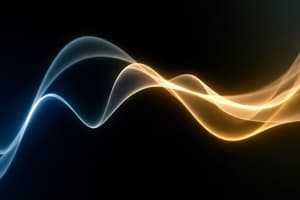Podcast
Questions and Answers
What is the correct order of the electromagnetic spectrum from longest to shortest wavelength?
What is the correct order of the electromagnetic spectrum from longest to shortest wavelength?
Which statement accurately describes the behavior of light when it hits a plane mirror?
Which statement accurately describes the behavior of light when it hits a plane mirror?
What type of image is formed by a curved mirror when the object is located between the focal point and the mirror?
What type of image is formed by a curved mirror when the object is located between the focal point and the mirror?
Which of the following regions of the electromagnetic spectrum is primarily used for communication and broadcasting?
Which of the following regions of the electromagnetic spectrum is primarily used for communication and broadcasting?
Signup and view all the answers
How does a curved mirror affect the size of an image compared to the object size?
How does a curved mirror affect the size of an image compared to the object size?
Signup and view all the answers
Which electromagnetic wave has the highest frequency?
Which electromagnetic wave has the highest frequency?
Signup and view all the answers
What type of image is typically formed by a plane mirror?
What type of image is typically formed by a plane mirror?
Signup and view all the answers
In which part of the electromagnetic spectrum do microwaves primarily fall?
In which part of the electromagnetic spectrum do microwaves primarily fall?
Signup and view all the answers
How does a convex mirror differ from a concave mirror in terms of image formation?
How does a convex mirror differ from a concave mirror in terms of image formation?
Signup and view all the answers
Which electromagnetic wave has the longest wavelength?
Which electromagnetic wave has the longest wavelength?
Signup and view all the answers
Study Notes
Electromagnetic Waves
- Electromagnetic waves are transverse waves that do not require a medium for propagation.
- They are produced by accelerating electric charges.
- They travel at the speed of light in a vacuum.
- Electromagnetic waves exhibit wave-particle duality, meaning they behave both as waves and as particles (photons).
- Examples include radio waves, microwaves, infrared radiation, visible light, ultraviolet radiation, X-rays, and gamma rays.
- The electromagnetic spectrum arranges electromagnetic waves by their frequency and wavelength.
Electromagnetic Spectrum
- The electromagnetic spectrum is a range of all types of electromagnetic radiation.
- It spans a broad range of frequencies and wavelengths.
- Different types of electromagnetic radiation have different properties and applications.
- The spectrum is typically divided into regions based on frequency and wavelength.
- These regions include radio waves, microwaves, infrared radiation, visible light, ultraviolet radiation, X-rays, and gamma rays.
- Each region has unique characteristics and applications.
Plane Mirrors
- A plane mirror is a flat mirror that reflects light to produce a virtual image.
- The image formed is upright and the same size as the object.
- The image distance equals the object distance.
- The image is laterally inverted. (left-right reversal)
- The angle of incidence equals the angle of reflection.
- A key characteristic is its ability to produce a virtual and laterally inverted image of an object.
Curved Mirrors
-
Curved mirrors are mirrors with a curved reflecting surface.
-
They are classified as concave or convex.
-
Concave mirrors:
- Converge light rays to a focal point.
- Can produce real or virtual images depending on the object's position.
- Used in telescopes, headlights, and shaving mirrors.
-
Convex mirrors:
- Diverge light rays.
- Only produce virtual, upright, and diminished images.
- Used in security mirrors and side-view mirrors of vehicles.
-
The focal length (f) is a critical parameter.
-
The image characteristics (real/virtual, upright/inverted, magnified/diminished) depend on the object's position relative to the mirror’s focal point.
General Properties of Mirrors
- Reflection follows the law of reflection (angle of incidence equals angle of reflection).
- Images formed can be real (invertible on a screen) or virtual (cannot be projected).
- The image characteristics (size, orientation, etc.) depend on the type and position of the mirror.
Multiple Choice Review Questions (Example, 50 items not presented here)
-
Question 1: Which of the following is a transverse wave in the electromagnetic spectrum?
- A) sound wave
- B) water wave
- C) light wave
- D) None of these.
-
Question 2: What type of image does a plane mirror produce?
- A) Real
- B) Virtual
- C) Enlarged
- D) Diminished.
-
Question 3: A concave mirror will produce what type of image when the object is placed beyond the centre of curvature?
- A) Real and inverted
- B) Virtual and upright
- C) Real and upright
- D) Virtual and inverted.
Studying That Suits You
Use AI to generate personalized quizzes and flashcards to suit your learning preferences.
Description
Explore the fascinating world of electromagnetic waves and the electromagnetic spectrum. Learn about the properties, types, and behavior of these waves, as well as their applications across various fields. This quiz covers essential concepts including wave-particle duality and the arrangement of waves based on frequency and wavelength.




